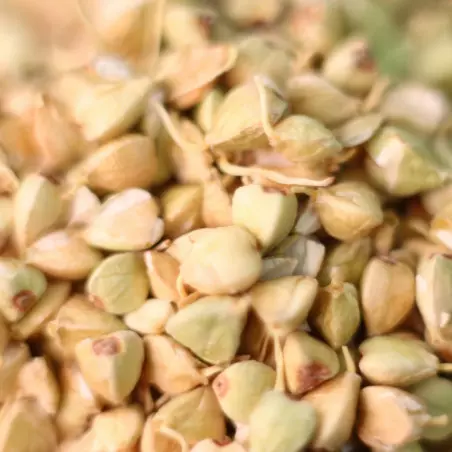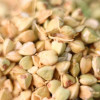Grandson and son of two generations of bakers, I can tell you that I have lived, breathed, eaten, and played with gluten, with flour everywhere, since my birth. A few decades later, scientific research is gradually shedding light on its effects on the body, establishing an undeniable link between diet and health. Between what Irène Grosjean calls "the glues" in the Life in Abundance, and the congestion of our elimination organs, gluten can generate numerous issues affecting our overall well-being.
For decades, our personal plant-based diet has been almost entirely gluten-free, with few exceptions, and we offer in living food "des" gluten-free alternatives which are some very nice superfoods to discover, such as tiger nut flakes "and the" sprouted buckwheat dehydrated, for example.
What is gluten?
Gluten is a general name for the proteins found in wheat, barley, rye, and triticale (a cross between wheat and rye). It acts like a true glue that helps foods maintain their shape, ensuring elasticity and moisture. Gluten can be found in a wide variety of foods, even those that would not initially be associated with grains.
Definition of gluten
Scientifically speaking, gluten is the protein complex primarily composed of gliadin and glutenin, which are present in the cereal grains mentioned above. These proteins play a critical role in determining the quality of flour in baking, retaining fermentation gases, which allows the dough to rise and form an airy and soft crumb.
However, it can be a real tough opponent for individuals suffering from disorders such as celiac disease. This autoimmune disease is triggered in response to the ingestion of gluten, damaging the lining of the small intestine.
For many people, the complete exclusion of gluten from their diet is essential to prevent digestive disorders, abdominal pain, and to restore nutritional balance.. "The" diet Adapted integrates from gluten-free foods and advocates for a living diet with options such as dehydrated sprouted buckwheat, which is naturally gluten-free and beneficial for health.
People choosing a vibrant and vegan lifestyle can also rely on this quality protein. Fortunately, the gluten-free products are becoming more and more varied, making thegluten-free diet accessible and diverse.
Why do flours contain more and more gluten ?
Over the decades, cultivated wheat has been genetically selected to contain higher levels of gluten to meet the demands of the food industry. This increased gluten improves baking properties, giving bakery products better elasticity and a softer texture, which is highly appreciated by consumers. However, This increase in gluten in wheat has negative repercussions on public health.. A high consumption of gluten can worsen conditions for people with diseases such as celiac disease and non-celiac gluten sensitivity. Additionally, some experts suggest that this overconsumption could contribute to an increase in digestive troublesand inflammations. While the industry continues to prioritize the technological qualities of gluten, it is essential to consider the health impacts:
- Study on the composition of wheat: A study conducted by Wageningen University in the Netherlands compared ancient and modern wheat varieties. The researchers found a 25 to 30% increase in gluten content in modern varieties compared to those cultivated 100 years ago .
- Genetic selection: The work on varietal selection, aimed at improving yields and technological properties, has led to a significant increase in gluten proteins in wheat, according to a study published in the journal. Cereal Chemistry . .
Health impacts
- Celiac disease It seems like your message is incomplete. Could you please provide the text you would like translated from French to English? The prevalence of the celiac disease has quadrupled over the past 50 last yearA study conducted by the Mayo Clinic in 2009 revealed that 1 in 133 people in the United States is affected by celiac disease, compared to 1 in 500 in the 1950s .
- Gluten sensitivity: A study published in the American Journal of Gastroenterology In 2012, it was indicated that approximately 6% of the population might suffer from non-celiac gluten sensitivity, a condition characterized by gastrointestinal and extra-intestinal symptoms after the ingestion of gluten.
- Digestive troublesIt seems like your message is incomplete. Could you please provide the full text you would like translated from French to English? an increase in digestive troublesConditions such as irritable bowel syndrome (IBS) have been observed, with an estimated global prevalence of between 10 and 15%. Although not all forms of IBS are related to gluten, high consumption of gluten can worsen symptoms in some people .
Studies and References
- Study on Wheat Varieties:
Rienks, M., & Schaafsma, G. (2000). The evolution of wheat grain quality and its nutritional implications. Wageningen University Research. - Study on genetic selection
A. S. Tatham, B. J. Miflin, and P. R. Shewry, Cereal Chemistry, Vol. 62, pp. 405-412, (1985). "The Beta-Turn Conformation in Wheat Gluten Proteins: Relationship to Gluten Elasticity"
Why some people avoid gluten
The elimination of gluten is essential for individuals with celiac disease, a chronic intestinal condition triggered by gluten causing a immune response which damages the small intestine. This hinders theabsorption of nutrientsand leads to a variety of digestive troublesA. A gluten-free diet is also adopted by some people suffering from non-celiac gluten sensitivity, causing similar symptoms but without the intestinal damage associated with celiac disease. It seems like your text is incomplete. Could you please provide the full sentence or context so I can accurately translate it for you? last years, lIt seems like your message is incomplete. Could you please provide the full text you would like translated from French to English? A gluten-free diet has become popular, including among individuals without intolerance, often as part of a pursuit of a vegan, plant-based, or raw diet aimed at achieving better nutritional balance.
Effects of gluten consumption on the body
In people with celiac disease, the ingestion of gluten triggers an autoimmune reaction leading to the atrophy of the villi in the small intestine, which disrupts theabsorption of nutrientsThe symptoms can be multiple, not limited to the gastrointestinal tract: abdominal paindiarrhea, bloating, but also anemia, fatigue, and even bone loss. In non-celiac individuals who are sensitive to gluten, consuming gluten can also lead to digestive and other symptoms, without causing intestinal damage.
Gluten-containing cereals
Wheat is the main culprit of gluten intolerance, but other grains to avoid are also crucial in a gluten-free diet are barley, rye, and triticale. Buckwheat, although its name suggests wheat, is naturally gluten-free, making it an ideal substitute. This is also the case for Tiger nut, which can be used whole or in flakes. "The" dehydrated sprouted buckwheat is a top-quality food which can be bought as is or prepared at home and which is valued in thegluten-free diet for its nutritional richness and high digestibility.
Processed foods containing gluten
When it comes to avoiding gluten for health reasons such as celiac disease or for a dietary preference, knowing the processed foods that contain gluten is essential. Gluten, a protein found in certain grains, can be hidden in many processed products, and the gluten content will of course vary depending on the food.
Processed foods very often containing gluten:
- Breads and pastries: generally contain wheat flour.
- Breakfast cereals: Many will be based on grains containing gluten unless otherwise specified.
- Snacks: Cookies, crackers, and cereal bars may include ingredients with gluten base.
- Prepared dishes: Sauces, soups, and prepared dishes may contain thickening agents. gluten base.
- Pasta and noodles: typically designed with wheat flour unless explicitly labeled gluten-free.
- Beers and fermented drinks: Many are produced from barley.
For those looking to exclude flour and gluten-containing products from their diet, whether they aim for a raw and vegan diet or suffer from digestive troublesYes, it is crucial to read labels carefully. Opt for alternatives such as dehydrated sprouted buckwheat, a true provision for a gluten-free diet, can help maintain a Nutritional balance. It seems like your text is incomplete. Could you please provide the full text you would like translated from French to English? abdominal painThey can frequently report a reaction to foods containing gluten, making it essential to prioritize the inclusion of gluten-free products and diets.
Gluten alternatives
Here is a proposal forgluten-free alternativesSure, please provide the text you would like to be translated from French to English.
Effects of gluten consumption on the body
Category | Potential Effects |
|---|---|
"With" It seems like your message is incomplete. Could you please provide the full text you would like translated from French to English?celiac disease | Atrophy of intestinal villi, malnutrition. |
Non-celiac gluten sensitivity | Digestive discomfort, abdominal painIt seems like your message is incomplete. Could you please provide the full text you would like translated from French to English? |
Without gluten-related conditions | Few or no effects except for wheat allergies. |
As part of a diet vegan and raw food, opt for gluten-free foods "like the" dehydrated sprouted buckwheat can enhance nutrient intake while avoiding complications related to gluten (2).
For people affected by the celiac disease or sensitive to gluten, the use of gluten-free products is essential for maintaining intestinal and overall health.
References:
- Sapone et al. Spectrum of gluten-related disorders: consensus on new nomenclature and classification. BMC Med. 2012.
- Dr. Gaétane Sternon, "A Living Diet for Sustainable Health", Jouvence Editions.
How to spot gluten in the store ?
Navigating the sometimes complex world of food productsIt requires a precise knowledge of the composition of foods in the ingredient list or of the raw materialsAttention to all foods at flour base, or containing flour mixWhen we talk about gluten, this stealthy protein is found in a multitude of products, often where we least expect it. This food camouflage poses significant risks for people suffering from celiac disease or others digestive troublesrelated to gluten.
It looks like your text got cut off. Could you please provide the complete text you would like translated? Food labelsIt seems like there might be a typo or an incomplete text. The letter "s" on its own doesn't form a complete word or sentence in French. Could you please provide more context or the full text you would like translated?
The reading of the list of ingredientsIt seems like the text you provided is incomplete or possibly a typo. Could you please provide the full text or clarify? Food labelsIt is an essential act to ensure a gluten-free diet. Ingredients containing gluten can be listed under different names, which requires a keen eye. Here are some typical examples to consider in the product choiceIt seems like your message is incomplete. Could you please provide the full text you would like translated from French to English?
- Wheat in all its forms (flour, semolina, germ), including its derivatives such as malt.
- Barley and derivatives including malts, extracts, and often used in beer.
- Rye, mainly found in certain breads and biscuits.
- Some food additives such as modified starches, dextrins, ", may come from gluten-containing sources."
- The presence of terms like "spices" and "natural flavors" can indicate traces of gluten and should be examined with caution.
Specific claims on packaging
Manufacturers of flour-based products responsibly indicate the presence or absence of gluten on their packaging. This way, individuals who are sensitive to or prefer to avoid gluten can choose products that are specifically labeled.
- Gluten-free : means that the product must not contain more than 20 ppm (parts per million) of gluten, a threshold considered low enough for the majority of people with celiac disease according to European regulations.
- Naturally gluten-free : informs that the ingredients used are gluten-free, but this does not guarantee that the product is free from cross-contamination.
- Certified gluten-free : This label is generally awarded by independent organizations that attest to a particular rigor in preventing contamination during production.
The tables below can be of great help:
Ingredients to Avoid | Safe Ingredients |
|---|---|
Wheat, barley, rye | Corn, rice, tapioca, quinoa |
Oats (no gluten-free guarantee) | Dehydrated sprouted buckwheat, Amaranth |
Malt, dextrin (except when labeled gluten-free) | Potato starch, arrowroot |
Symbols on Packaging | Meaning |
|---|---|
Crossed-out wheat ear | Certified gluten-free product |
"Gluten-free" | Less than 20 ppm of gluten |
"Naturally gluten-free" | Originally gluten-free ingredients |
Adopt a gluten-free diet relies on constant education and a thorough examination of food productsKnowledge and vigilance are the keys to protecting oneself and preserving theNutritional balance essential to a healthy and fulfilling life.
To Look For on Your Labels
- Gluten-free products certified: They offer a warranty for consumers.
- Ingredients to exclude: It looks like your message is incomplete. Could you please provide the full text you would like translated from French to English?Wheat flour, barley, rye, and derived products.
- Terms such as "gluten-free buckwheat"or "dehydrated sprouted buckwheat":" These labels indicate a food suitable for a raw and vegan diet, while respecting the needs of a person suffering from celiac disease.
Buckwheat, despite its misleading name, is gluten-free and stands out particularly when it is sprouted and dehydrated, which will certainly change your eating habitsIt seems like your message is incomplete. Could you please provide the full text you would like translated from French to English? This transformation increases the bioavailability of its nutrients, particularly B vitamins, antioxidants, and all of its amino acids, making it suitable for vegan diets (Zieliński H et al., Food Chemistry, 2002).
Uses of sprouted buckwheat | Advantages |
|---|---|
In flakes | Perfect for breakfasts, rich in protein |
In dehydrated sprouted seed | Ideal as a side dish or in salads |
It seems like you only provided the letter "F." Could you please provide the full text you would like translated?Buckwheat flour sprouted dehydrated | Used for making pastries or crepes |
Engaged and remarkable for its versatility, dehydrated sprouted buckwheat has become a must-have for those looking to enrich their diet while staying true to a gluten-free approach.
Tiger nut, a superfood with no known allergies
The sedge, The tuber of Cyperus esculentus is still relatively unknown to thegluten-free diet. We were the first to introduce it in France in 2018. A true superfood, it has not caused any known allergies to date, making it a preferred choice for people seeking healthy and safe food options (Monteagudo C and Ros G, Plant Foods for Human Nutrition, 2016).
Excellent in taste, the Tiger nut is also rich in fiber, antioxidants, magnesium, and iron. It is a versatile ingredient, used in powder form, as milk, or even as snacks to munch on (soaked overnight in this case). Its low glycemic index makes it ideal for consumption aimed at preventing glycemic imbalances.The tiger nut, often overlooked, is a tuber with exceptional properties and a superfood with no known allergies. Some even describe it as the ideal digestive solution, especially for those who endure digestive troubleschronic conditions. Naturally gluten-free, tiger nut serves as an essential nutritious alternative for people suffering from celiac disease or some gluten-free flours "and the foods that contain it from their diet."
Key nutritional values of tiger nuts:
- Rich in fiber: promotes a healthy diet and intestinal transit.
- High mineral content: ensures theNutritional balance with magnesium, potassium, and iron.
- Plant-based protein resource: perfect for a vegan diet.
- Interesting lipid profile: contains monounsaturated fatty acids beneficial for heart health.
The tiger nut can be consumed in various ways: fresh, dried, in the form of flour, flakes, raw milk, spread, or even oil (although it is not yet available in France), making it particularly suitable for diverse culinary preparations. Enthusiasts of thegluten-free diet "will be able to savor its sweet flavor and easily integrate it into their" diet. In summary, the tiger nut is a powerful little seed that is making its mark in the world of superfoods. gluten-free foods, a guarantee of digestive well-being without sacrificing taste or nutritional value..jpg)
Dehydrated sprouted buckwheat, a multi-purpose superfood
Le (The) buckwheat (we are talking about hulled buckwheat, easily available in organic sectionSprouted and dehydrated, often celebrated in the world of raw and vegan food, it stands out as a versatile superfood. Gluten-free, buckwheat has become a staple in kitchens where gluten is excluded. wheat flour and other cereals that may cause digestive troublesSprouting buckwheat and then dehydrating it makes it crunchy and very digestible. Non-sprouted buckwheat is indeed not very suitable to be eaten raw as is.
Nutritional Richness of Dehydrated Sprouted Buckwheat
- Complete proteins: source of all essential amino acids.
- Minerals: rich in iron, magnesium, and selenium.
- Vitamins: contains vitamins B and E.
Thanks to his/her/its Nutritional balance, it is particularly popular among people suffering from celiac disease or food intolerances, as it allows for the structuring of meals that respect these restrictions while providing optimal satiety.
Additionally, sprouted buckwheat can be used in various ways in cooking, throughout different meals. Its crunchy texture makes it easy to sprinkle. It helps to reduce abdominal painassociated with celiac diseases and improves the diet by offering a tasty and healthy alternative.
It looks like your text is incomplete. Could you please provide the full text you would like translated from French to English?gluten-free diet is not just a simple trend, but a vital necessity for people affected by celiac disease and a relief for those with digestive troublesIt's a quest for theNutritional balance, digestive well-being where abdominal paindiscomforts disappear to make way for a living, rich, and diverse diet.
Gluten-free recipes with Dehydrated sprouted buckwheat and Tiger nut flakes
Crunchy morning muesli
- 100g of dehydrated sprouted buckwheat
- 30g of tiger nut flakes
- 20g of freeze-dried fruits
Mix with some fresh seasonal fruits and a fillet of liquid fruit sugar as well as a plant-based milk and some cacao nibs
Vegan Energy Balls
- 80g of dehydrated sprouted buckwheat
- 50g of tiger nut flakes
Add two medjool dates and activated almond puree and form balls
Buckwheat and tiger nut flakes, both gluten-free, are perfect allies for excluding traditional flour from your diet.. . They offer a tasty response to the gluten-free products, sharing symphonies of flavors that delight and support a vibrant and healthy diet for everyone, vegan or not.
Conclusion and recommendations for a gluten-free raw food diet
Conclusion and recommendations for a gluten-free raw food diet:
The adoption of a gluten-free diet goes well beyond the simple act of excluding the wheat flour. She is deeply rooted in a commitment to the pursuit of a Nutritional balance, relying mainly on foods, beneficial to gut health, without the risk of digestive troublesfrequently associated with gluten. The sweet potato, raw grated or in sauce or cooked is a very good choice.
Table of gluten-free alternatives:
Traditional ingredient | Gluten-free alternative |
|---|---|
Wheat flour | Buckwheat flour Sure, I'd be happy to help! Please provide the text you would like translated from French to English. rice flour |
Standard bread | Bread gluten-free buckwheat |
Semolina pasta | Buckwheat pasta |
For people affected by celiac disease, a gluten-free raw food diet is not an option but a necessity. The complete elimination of gluten is imperative to prevent intestinal inflammation and abdominal painHowever, even individuals without celiac disease can benefit from this diet through improved digestion and better vitality.
It is essential to prioritize certified productswithout gluten and to rely on naturally gluten-free foods, such as buckwheat, or quinoa while ensuring dietary diversification to guarantee a complete intake of essential nutrients. Innovative products in thegluten-free diet, such as mixes of dehydrated sprouted seeds, or the dehydrated sprouted buckwheat "or the" tiger nut flakes, today meet the expectations of flavor and digestive well-being.
In summary, a gluten-free raw food diet is accessible, nutritious, and can be delicious, thereby contributing to overall quality of life and digestive well-being.

















